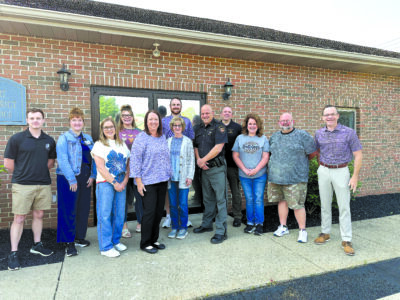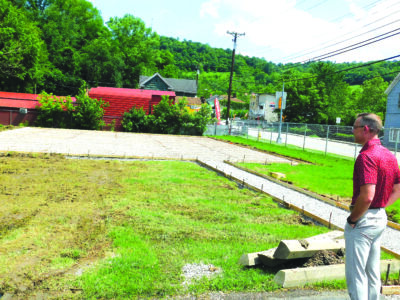‘Up and up and up’ — health official says no end to new infections in sight
ST. CLAIRSVILLE — Belmont County Deputy Health Director Robert Sproul told the health board during its Monday meeting that local cases of COVID-19 continue to spike.
At the end of the day, Belmont County had reached 1,231 total cases since the onset of the pandemic with 447 people actively infected. There have been 751 recoveries. Six people are hospitalized, and the number of deaths associated with the virus has increased from 25 to 27. Sproul said the man in his 90s and the woman in her 80s who died over the weekend while infected with the virus were at a long-term care facility.
“Our numbers just keep moving up and up and up and up,” Sproul said. “We had 29 this morning. We’ve been consistently going up and up. The staff’s been doing a great job, but they are overwhelmed. It’s getting very difficult just on the volume of calls we’re getting in, the calls we’re putting out, the labs getting the results back with the people. It has been very difficult, but they have been doing a very good job under extreme circumstances.”
Sproul said his department was reaching out to the National Guard about the possibility of hosting another round of pop-up testing sites in the county. This summer, Belmont County locations hosted three pop-up tastings in three successive weeks. Sproul said there are no details yet about when this might come about.
He added that Belmont County remains designated Level 2, or orange, on the state’s color-coded risk assessment map, but he said it is “surrounded” by Level 3, or red, counties. Where the risk of COVID-19 transmission is higher.
Sproul said there are several factors in Belmont County that may help prevent it from meeting the criteria for red status.
“There are specific markers we have to make,” he said, noting one of the markers is an increase in the number of intensive care beds occupied by coronavirus patients.
“All of our ICU beds are in West Virginia, so they can’t count those numbers. Increase in doctors visits — most of our doctors are in West Virginia, so you can’t hit those,” he said. “With the state’s guidance, we’re still saying it’s orange with high incidence.”
St. Clairsville-Richland City Schools had switched to remote learning last week and had plans to return to in-person education this week, but the district has extended remote learning to Friday.
“They said they had a huge spike over the weekend of cases,” Sproul said.
He added that East Richland Christian School is also still using remote learning, along with Martins Ferry City Schools, Union Local and Shadyside Local school districts and Bridgeport high School. Sproul said Barnesville Exempted Village School District has shifted to a hybrid of remote and in-person learning.
“Everybody’s just seeing the numbers and trying to be cautious,” Sproul said. “Everybody’s having numbers spike up. It’s all across the county.”
The Martins Ferry school district is set to resume in-person classes this coming Monday.
Shadyside Superintendent John Haswell said cases within the schools are rising.
“Within a 24-hour period we had three adults test positive between Friday and Saturday,” Haswell said. “With a staff member down in Jefferson and a staff member at the high school, we just decided to take the safe route and go remote for this week. We’ll evaluate at the end of this week. … This weekend. If we continue to get more cases, we’ll continue to go remote.”
He reminds people to take the virus seriously. Haswell added he is confident in the district’s readiness.
“We’ve been preparing for this for months now. … Everyone is cooperating.”
Union Local Superintendent Ben Porter said three staff and two students have tested positive, with one other student awaiting results. About 50 people associated with the schools are quarantined due to possible exposure to COVDI-19. The district still plans to resume in-person learning Monday.
“We will judge that a little later in (the) week,” Porter said in a text message.
Barnesville Exempted Village Schools could not be reached for comment.
Sproul mentioned that contact tracing at schools is more easily done in elementary classes, where students generally remain in one classroom, than in the high schools, where they frequently moved to different classes.
Ohio Gov. Mike DeWine addressed rising COVID-19 numbers across the state in an address to Ohioans on Monday. He and Bruce Vanderhoff, incoming chief medical officer of the Ohio Department of Health, voiced concern that many caregivers might contract the virus but are more likely to do so in their communities than in hospitals.
As of Monday, there were over 2,500 hospitalizations statewide, up from 2,000 hospitalizations Thursday. A total of 154 hospitalizations were reported in 24 hours.
“In Ohio, we are seeing an unprecedented spike in hospital utilization and it is impacting all areas of the state. While we are better prepared with personal protective equipment and physical capacity, what we are seeing now is an increasing demand on our staffing,” said Dr. Vanderhoff. “If we don’t control the spread of this virus, we won’t be able to care for those who are acutely ill without postponing important, but less urgent, care. We anticipate that this kind of shift could happen in a matter of weeks if trends don’t change.”
“The COVID-19 pandemic is becoming more dire for Ohio as hospitalizations have escalated 350 percent in the past 50 days to 2,533 COVID patients in Ohio hospitals today,” said Mike Abrams, president and CEO, Ohio Hospital Association. “Our hospitals are capable of managing capacity needs, but we must stem the spread now. … We can stop this spread, and we call on Ohioans to join hospitals and caregivers to take action now and do the right thing to slow the spread.”
At the beginning of the pandemic, Governor DeWine worked with the Ohio Hospital Association to develop a comprehensive statewide public health system to ensure that all Ohioans have access to quality care during the pandemic. As part of this process, the state was divided into three healthcare zones. Southeast Ohio, including Belmont, Harrison, Jefferson and Monroe counties, is in Zone 2.
On Nov. 2, Zone 2 hit a milestone of 400 patients in the hospital; by Friday, the number surpassed 500 patients. Monday there were over 560 COVID-19 patients hospitalized with COVID-19 in Zone 2.




